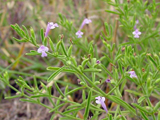Native Plants

Q. Who is Mr. Smarty Plants?
A: There are those who suspect Wildflower Center volunteers are the culpable and capable culprits. Yet, others think staff members play some, albeit small, role. You can torture us with your plant questions, but we will never reveal the Green Guru's secret identity.
Did you know you can access the Native Plant Information Network with your web-enabled smartphone?
Ask Mr. Smarty Plants is a free service provided by the staff and volunteers at the Lady Bird Johnson Wildflower Center.

rate this answer
Thursday - November 01, 2012
From: Camp Wood, TX
Region: Southwest
Topic: Edible Plants
Title: Edible native plants for Camp Wood, TX
Answered by: Nan Hampton
QUESTION:
We live northwest of Camp Wood, TX in the uplands, so our soil is shallow with caliche and limestone beneath and is clay-like with the typical higher pH. Are there any native trees, bushes, vines, or plants that can survive in this soil type that produce edible food in some quantity. We do have agarita and prickly pear which has edible fruits, but not in much quantity.ANSWER:
We have a list of Edible Native Texas Plants that lists plants found in our edible plants garden. Not all of those are native to your area, of course, but you can determine which ones are by opening the species page for each plant and scrolling to the bottom of the page. When you find the entry for ADDITIONAL RESOURCES there click on the USDA link. This will take you to the USDA Plants Database page that has a distribution map for that plant. If you click on Texas on the map, it will show you the distribution by county for the plant and you can determine if it occurs in or adjacent to Real County. If you click on the county distribution map again, it will give you the names of the counties as well.
Below are some edible native plants that occur in or adjacent to Real County:
Allium canadense (Meadow garlic) and Allium drummondii (Drummond's onion)
Cercis canadensis var. texensis (Texas redbud). The flowers are delicious in a salad or added to pancake batter or muffins.
Diospyros texana (Texas persimmon). According to Delena Tull in Edible and Useful Plants of Texas and the Southwest:
"When fully ripe, the sweet rich fruit has a flavor that resembles that of a prune. The astringency of the unripe fruit makes your mouth pucker and leaves a horrid taste, so use only the soft juicy fruit."
Hedeoma drummondii (Drummond's false pennyroyal) smells and tastes like peppermint and can be used as herbal flavoring and teas.
Juglans microcarpa (Little walnut) is delicious but difficult to extract from its hard case.
Malvaviscus arboreus var. drummondii (Turk's cap or turkscap) fruits can be eaten raw or cooked.
Monarda citriodora (Lemon beebalm) makes a strong-flavored tea.
Oenothera speciosa (Pink evening primrose) young leaves are delicious in a salad or cooked as a green.
Oxalis drummondii (Drummond's woodsorrel) can be used as addition to a salad or as a flavoring in soups or vegetable dishes.
Tradescantia gigantea (Giant spiderwort) young tender stems, leaves and flower parts can be used raw in salads or added to soups, stews and sauteed vegetables.
Vitis cinerea var. helleri (Winter grape)
Vitis monticola (Sweet mountain grape)
Prosopis glandulosa (Honey mesquite) meal made from the roasted and ground beans can be used in many recipes.
Celtis laevigata (Sugar hackberry) has edible berries.
Please see the answer to a previous question about edible plants around Austin, TX. Although not all the plants mentioned in the previous question occur in or adjacent to Real County, the description of the uses of the plants that do are relevant to your question.
I also recommend Delena Tull's Edible and Useful Plants of Texas and the Southwest and Carolyn Harvel's and Billie Turner's Recipes from the Wild: Cooking with Native Texas Plants. Also, you can fond food plants used by Native Americans on the Texas Beyond History webpage.
From the Image Gallery
More Edible Plants Questions
What variety of Opuntia is best for eating in Boerne, TX.
September 26, 2011 - Which variety of Opuntia, is best for eating the pads and which are the ones best eaten for fruit?
view the full question and answer
Will a chile pequin survive winters in Garden City, Kansas
March 24, 2010 - Dear Mr. Smarty Pants,
I am trying to determine if a chile pequin (Capsicum annuum) can survive Kansas winters. My sister lives in Killeen, TX, and has a couple of these bushes in her yard. She broug...
view the full question and answer
Smarty Plants wild sweet pea
July 28, 2005 - We were asked if the seed pods of the wild sweet pea are edible. (California)
view the full question and answer
Edibility of bur oak (Quercus macrocarpa) acorns
October 24, 2007 - Is the acorn of the Bur Oak edible?
view the full question and answer
Citrus trees for Austin
May 21, 2008 - I am looking for citrus that grows in the Austin,Tx area.
Could you offer any suggestions please?
view the full question and answer
| Support the Wildflower Center by Donating Online or Becoming a Member today. |

